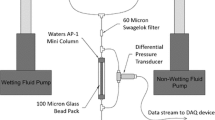Abstract
A dynamic pore‐scale network model is formulated for two‐phase immiscible flow. Interfaces are tracked through the pore throats using a modified Poiseuille equation, whereas special displacement rules are used at the pore bodies. The model allows interfaces to move over several pore‐lengths within a time step. Initial computational results are presented for a drainage experiment to demonstrate some of the features of the model.
Similar content being viewed by others
References
M. Blunt and P. King, Relative permeabilities from two-and three-dimensional pore-scale network modelling, Transport in Porous Media 6 (1991) 407–433.
J.S. Buckley, Multiphase displacements in micromodels, in: Surfactant Science Series, Vol. 36 (Marcel Dekker, New York, 1991) pp. 157–189.
M.A. Celia, P.C. Reeves and L.A. Ferrand, Recent advances in pore-scale models for multiphase flow in porous media, in: Reviews of Geophysics, Supplement, U.S. National Report to International Union of Geodesy and Geophysics 1991–1994 (July 1995) pp. 1049–1057.
M. Chaouche, N. Rakotomalala, D. Salin, B. Xu, and Y. C. Yortsos, Invasion percolation in a hydrostatic or permeability gradient: Experiments and simulations, Phys. Rev. E 49(5) (1994) 4133–4139.
G.N. Constantinides and A.C. Payatakes, Three-dimensional simulation of immiscible displacement of oil ganglia in consolidated porous media, in: Proc. Euro. Symp. Enhanced Oil Recovery (1988) p. 965.
G.N. Constantinides and A.C. Payatakes, A theoretical model of collision coalescence of ganglia in porous media, J. Colloid Interface Sci. 141 (1991).
G.N. Constantinides and A.C. Payatakes, Network simulation of steady-state two-phase flow in consolidated porous media, AIChE J. 42(2) (1996) 365–382.
M.M. Dias and A.C. Payatakes, Network models for two-phase flow in porous media, Part 1. Immiscible microdisplacement of non-wetting fluids, J. Fluid Mechanics 164 (1986) 305–336.
M.M. Dias and A.C. Payatakes, Network models for two-phase flow in porous media, Part 2. Motion of oil ganglia, J. Fluid Mechanics 164 (1986) 337–358.
A.F.L. Dullien, Porous Media: Fluid Transport and Pore Structure (Academic Press, New York, 2nd ed., 1992).
E.B. Dussan, Immiscible liquid displacement in a capillary tube: The moving contact line, AIChE J. 23(1) (1977) 131–133.
I. Fatt, The network model of porous media, I. Capillary pressure characteristics, Petroleum Trans. AIME 207 (1956) 144–159.
I. Fatt, The network model of porous media, II. Dynamic properties of a single size tube network, Petroleum Trans. AIME 207 (1956) 160–163.
I. Fatt, The network model of porous media, III. Dynamic properties of networks with tube radius distribution, Petroleum Trans. AIME 207 (1956) 164–181.
W.G. Gray and S.M. Hassanizadeh, Unsaturated flow theory including interfacial phenomena, Water Resour. Res. 27 (1991) 1855–1863.
W.G. Gray and S.M. Hassanizadeh, Macroscale continuum mechanics for multiphase porous-media flow including phases, interfaces contact lines, and common points, Adv. Water Res. 21(4) (1998) 261–281.
S.M. Hassanizadeh, Dynamic effects in the capillary pressure-saturation relationship, in: Proc. of 4th Int. Conf. on Civ. Eng., Vol. IV: Water Resources and Environmental Engineering, Sharif U. of Tech., Iran (1997) pp. 141–149.
S.M. Hassanizadeh and W.G. Gray, General conservation equations for multi-phase systems: 1. Averaging procedure, Adv. Water Res. 2(3) (1979) 131–144.
S.M. Hassanizadeh and W.G. Gray, Mechanics and thermodynamics of multiphase flow in porous media including interface boundaries, Adv. Water Res. 13(4) (1990) 169–186.
S.M. Hassanizadeh and W.G. Gray, Thermodynamic basis of capillary pressure in porous media, Water Resour. Res. 29 (1993) 3389–3405.
C. Huh and L.E. Scriven, Hydrodynamic model of steady movement of a solid/liquid/fluid contact line, J. Colloid Sci. 35 (1971) 85–101.
J. Koplik, Creeping flow in two-dimensional networks, J. Fluid Mech. 119 (1982) 219–247.
J. Koplik and T.J. Lasseter, Two-phase flow in random network models of porous media, Soc. Petroleum Engrg. J. 2 (1985) 89–100. Also appeared as Soc. Petroleum Engrg. Paper 11014 (1982).
N.R. Morrow, ed., Interfacial Phenomena in Petroleum Recovery, Surfactant Science Series, Vol. 36 (Marcel Dekker, New York, 1991).
R.A. Novy, P.G. Toledo, H.T. Davis and L.E. Scriven, Capillary dispersion in porous media at low wetting phase saturations, Chem. Engrg. Sci. 44(9) (1989) 1785–1797.
P.C. Reeves, The development of pore-scale network models for the simulation of capillary pressuresaturation-interfacial area — relative permeability relationships in multi-fluid porous media, Ph.D. thesis, Princeton University (1997).
P.C. Reeves and M.A. Celia, A functional relationship between capillary pressure, saturation, and interfacial area as revealed by a pore-scale network model, Water Resour. Res. 32 (1996) 2345–2358.
M. Sahimi, Flow and Transport in Porous Media and Fractured Rock (VCH, Weinheim, Germany, 1995).
D. Stauffer and A. Aharony, Introduction to Percolation Theory (Taylor & Francis, London, 2nd ed., 1992).
J. van Brakel, Pore space models for transport phenomena in porous media: Review and evaluation with special emphasis on capillary liquid transport, Powder Technology 11 (1975) 205–236.
S.C. van der Marck and J. Glas, Pressure measurements during forced imbibition experiments in micro-models, European J. Mech. B Fluids 16 (1997) 681–692.
S.C. van der Marck, T. Matsuura and J. Glas, Viscous and capillary pressures during drainage: Network simulations and experiments, Phys. Rev. E 56 (1997) 5675–5687.
E.W. Washburn, The dynamics of capillary flow, Phys. Rev. 17 (1921) 273–283.
C. Zarcone, R. Lenormand and E. Touboul, Numerical models and experiments on immiscible displacement in porous media, J. Fluid Mech. 189 (1988) 165–187.
Author information
Authors and Affiliations
Rights and permissions
About this article
Cite this article
Dahle, H.K., Celia, M.A. A dynamic network model for two‐phase immiscible flow. Computational Geosciences 3, 1–22 (1999). https://doi.org/10.1023/A:1011522808132
Issue Date:
DOI: https://doi.org/10.1023/A:1011522808132




